Pigpen? Check! Food source? Check! Lots of fresh water? Check!
You’ve made the decision to raise hogs for survival. You’ve lined everything up. You’re ready to go. Except something is still missing, you need to buy some hogs.
But what kind should you get? With so many breeds out there, how do you know which one is best? Is one kind of pig better than another kind?
Is There One Breed of Pig That’s Best?
The short answer is no. The long answer is, there’s a breed of pigs, or a crossbreed, that’s best for you and your farm. What’s best for you might not be best for me.
There are several things to think about before selecting a particular breed.
Four Factors to Consider Before Picking a Breed
Before you bring hogs home, take a few moments to research the breed you’ll be getting. In particular, you’ll want to look at the following things.
Temperament
Where will you be raising your pigs? Will they have lots of room to roam, or just a small area? Will the pigs be around other animals or small children?
Some breeds of pigs are docile. Others are more aggressive. There are pros and cons to both.
If predators attack your farm animals, a more aggressive pig might fare better. Conversely, if you have small children, you’ll probably want a gentler pig. Remember that temperament can vary, even across breeds. No two pigs are the same.
If you’re picking out breeding stock, be sure to ask your farmer what character traits they’re breeding for. Also, check out the pigs in person if possible. That’ll help you make an informed decision.
Size
In addition to temperament, pigs vary in size. Some pigs get huge. Others are smaller. Some pigs produce a lot of lard. Others are known as bacon pigs, producing a lot of lean meat.
How much meat will you be able to store in a survival situation? How much lard will you use? You’ll want to honestly answer these questions, and select a breed accordingly.
Where Are They Being Raised?
Modern pigs have been bred to survive in confinement. Commercial farmers have used selective breeding to ensure the pigs will stay alive on concrete, eating exactly the same food for its entire life.
If you prefer your pigs to act like pigs, and be raised humanely, modern breeds may not be what you’re looking for. Heritage pigs are breeds that were popular back before CAFOs entered the scene. They were the hogs that farmers and homesteaders raised.
For survival situations, you’ll want a pig that grows well on pasture, dairy, and scraps—foods that you can scrounge up even in the worst of times. Pigs who are used to eating only hog feed won’t be as useful when the SHTF.
Location
What hogs are available where you are? You can bring in pigs from far away to add to your line, but that definitely adds to the cost. Local pigs have the advantage of being local. You know they’re adapted to your climate. That’s always a plus.
Ten Breeds of Hogs to Consider
Since I don’t have time or space to dive into every single breed of hog available, I’ve compiled information for ten common breeds. These are well suited for survival situations. Any of them would be an ideal addition to a homestead.
1 – Berkshire
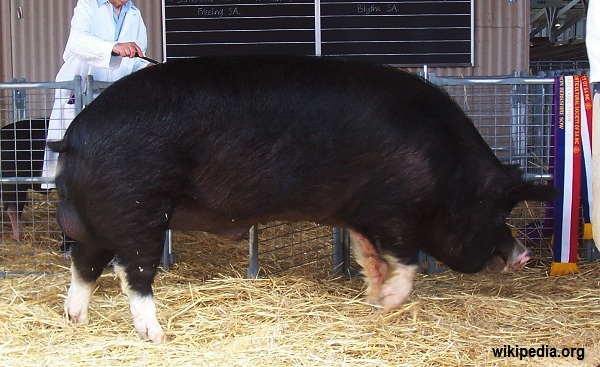
Discovered several hundred years ago in Berkshire County, UK, the Berkshire is dark with white points. This coloring means they’re less prone to sunburn than lighter colored hogs. These friendly, curious hogs are a hardy breed. They hold up well over long, cold winters, as long as they have proper shelter to take cover. They’re adaptable hogs, and can thrive in many environments.
To help lower the food bill, Berkshires are able to graze on pasture. They grow more slowly than some other breeds, but their meat is delicious. In fact, they’re known as the favorite pork breed in Japan.
Berkshires are larger than many breeds. When mature, they average 600 pounds.
The mama Berkshires have good mothering skills. They produce a lot of milk, which helps the piglets get off to a good start.
2 – Duroc
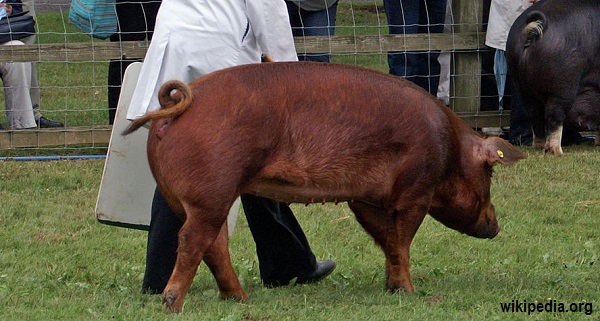
Durocs are one of the most common breed of hog in the world. With the ability to convert feed into lean muscles, Duroc boars played an important role in breeding lines for factory farms.
Despite their use in confinement lines, Durocs are an ideal outdoor pig. Their thick, red coat provides protection from cold winter weather. When the weather warms the coat molts, allowing these pig to thrive during dry, hot summers.
They enjoy running and grazing on pasture, but their growth will slow considerably. To maintain the quick growth, these hogs need good quality feed.
Durocs are medium sized pigs. When mature, the sows range from 450-650 pounds. Boars are slightly larger, with an average range of 500-750 pounds.
Historically Durocs were considered an aggressive breed. However, many farmers have successfully bred out much of the aggression. It’s still a trait to be aware of though.
3 – Tamworths
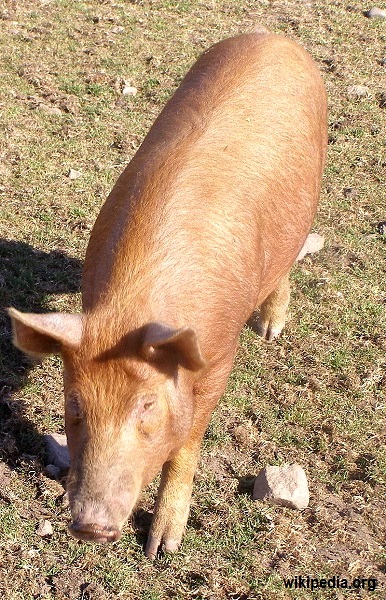
These ginger colored hogs perform well on pasture, earning them the nickname Irish Grazers. Their long snouts are perfect for rooting and foraging. They also have long legs.
Because they have smaller bones, Tamworths typically produce a better ratio of useable meat. Their hanging weight is a higher percentage than many other breeds. When mature, both sows and boars average 500-600 pounds. They are an active, medium sized hog.
Their athletic personality means Tamworths require solid fencing. Be sure to have it installed before you bring them home.
Tamworths produce large litters, and the sows are usually able to care for them. Piglets are usually active, and full of vitality.
4 – Large Black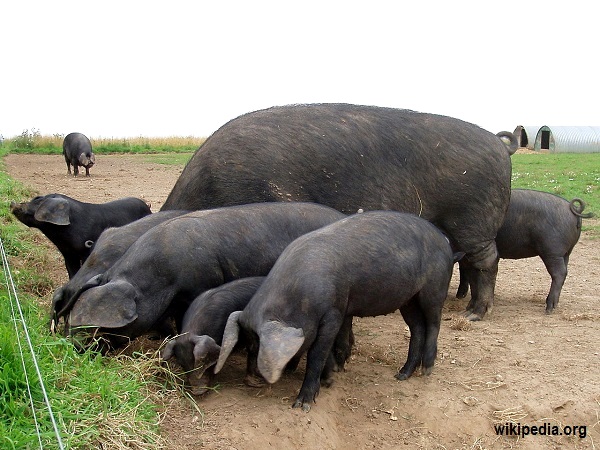
Large black pigs are named for both their size and their color. They average 700 pounds. Because they’re bigger than many other breeds, you’ll need to make sure your housing is large enough for your herd.
These pigs produce tender meat with excellent flavor, especially when allowed to forage. They’re well suited for grazing in wooded areas. The nuts and other food they find plays a role in the flavor of their meat.
Their docile personality makes pasturing Large Blacks simple. Many farmers have success with just a single strand of electric wire.
Large Black sows are excellent mothers, and usually have large litters. Obese sows can have problems with fertility, so it’s important to keep their weight in check.
5 – Gloucestershire Old Spot
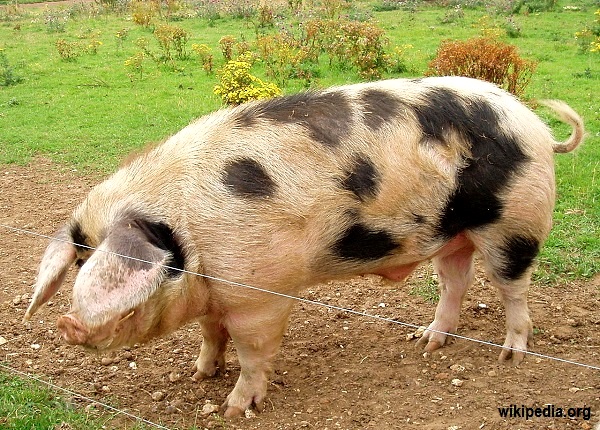
White hogs with black spots, Gloucestershire Old Spots grow well from forage. They take your agricultural by-products like whey and bruised fruit and turn it into delicious meat. These are lard pigs, even though they aren’t as large as others breeds. Old Spots average only 500 pounds upon maturity. But, they have a higher ratio of fat compared to the bacon breeds.
With their white skin, this breed is prone to sunburn. Be sure to provide them with plenty of shade and mud to wallow in.
As far as temperament goes, Old Spots are docile. They aren’t aggressive, and are known as easy keepers. They do know how to bust fences though, so make sure yours are tight!
Gloucestershire Old Spot sows are good mothers. They average nine piglets per litter, though many sows will have more. Their milk production is high, helping the piglets grow.
6 – Hereford
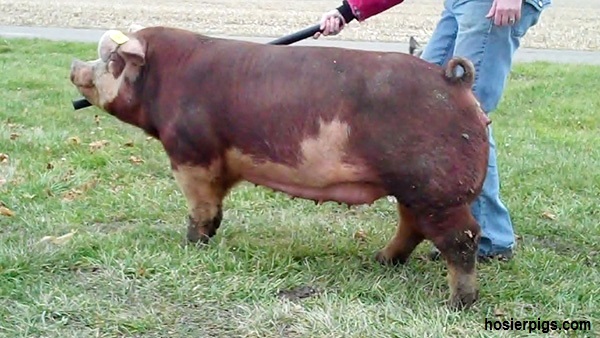
Hereford hogs were bred to match the coloring pattern of the cattle with the same name. They’re reddish with a white face, legs, and belly. Herefords are large pigs. At maturity, males average 800 pounds. The sows average 600 pounds. These hogs grow quickly, and fatten easily. They often reach ideal slaughter weight in 5 months while eating less than many other breeds.
They are easygoing pigs, and typically docile. This temperament makes Herefords ideal for first time handlers. As such, 4-H children often use them.
Adaptability is another positive character trait for Herefords. They do well on pasture or in an enclosed pen. With their strong rooting ability, Herefords make great tillers.
Sows of this breed are prolific. They average 10 piglets per litter, and are normally good mothers.
7 – Yorkshire
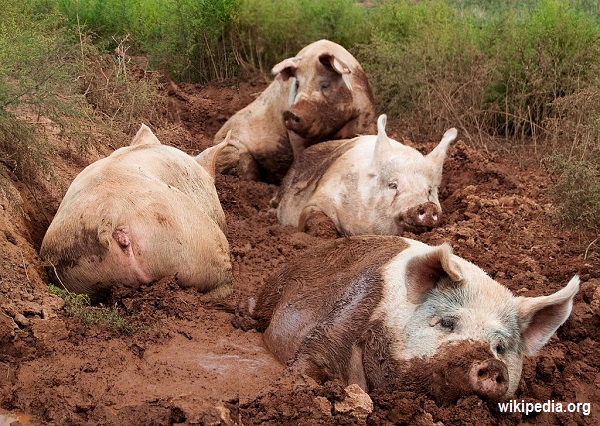
Currently the most common pig in the United States, Yorkshires are also known as English Large Whites. They have light pink skin that’s covered in thin white hair. Their ears are erect. Yorkshires are used in many breeding programs because they aren’t fatty. While they are large pigs, they are very muscular. This lean meat means they are bacon pigs, not lard pigs.
Pasture can make up part of a Yorkshire’s diet. They are hardy, and can handle cold winters and hot summers.
In addition to highly desirable meat, the Yorkshires also bring excellent mothering genes to breeding programs. They have large litters, and take care of their young well.
8 – Mulefoot
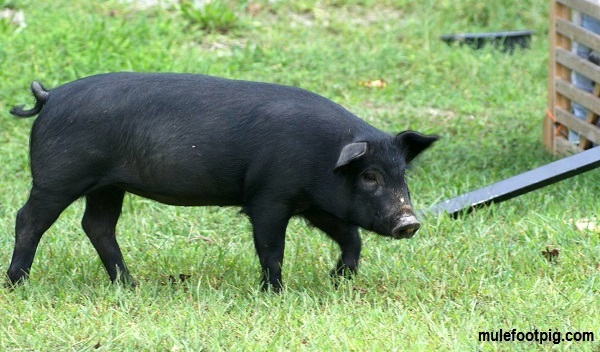
The hoof of a Mulefoot differs from other pigs. It’s not cloven, so it’s like a mule or a donkey. These hogs are solid black, though some will have white points.
Mulefoot hogs are smaller than many other breeds, averaging 400-600 pounds. Because of their small size, the pork chops will be smaller. Don’t let the smallness fool you though; the marbled meat is tender and tasty.
These hogs are active, but not aggressive. They’re good at grazing, and do well in many climates. Their unique hooves allow them to thrive even in wet areas.
Mulefoot sows are calm mothers. They average 5-6 piglets with each litter.
9 – Red Wattle

The Red Wattle is the only domestic hog with a wattle. These flaps of skin on the neck are not believed to have any particular use. They are large pigs, with the boars averaging 750 pounds when fully grown. Despite their size, they produce high quality lean meat that’s favored by many chefs.
Because of their size, you’ll need to make sure your structures are big enough to accommodate. The good news is that Red Wattles are hardy, and easily adapt to a variety of climates. They thrive on pasture, which can help lower your production costs.
As far as temperament goes, Red Wattles are very docile. Many farmers consider this breed among the easy keepers.
Red Wattles are attentive mothers. Sows average 9-10 piglets per litter.
10 – Hampshire
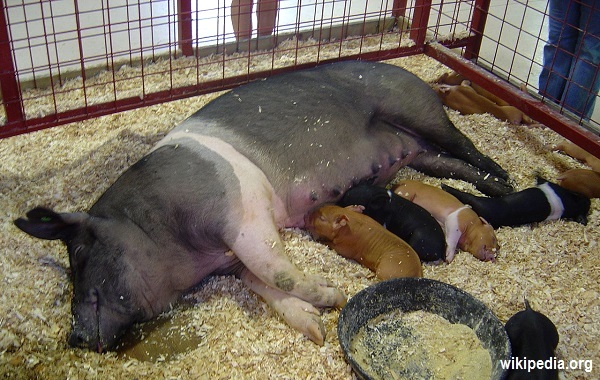
Hampshire hogs feature a unique look. They’re black with a white belt around their midsection that covers their front legs. With their erect ears, they can hear what’s going on around them. They are very curious pigs. However, they are docile.
They are excellent foragers, and gain weight quickly. Hampshire meat is prized as being extremely lean. These are definitely not a lard breed.
Hampshires are known for their quick growth. It takes less time to raise them to market weight. Additionally, large litters are common for Hampshire sows, so you’ll have plenty of pigs around to raise.
Before You Start Breeding Hogs
Before jumping into a breeding program of your own, I’d recommend starting with a couple of seasonal piglets. This will allow you to test your desired breed of pig in your environment.
You can check out your fences, and make sure they’ll keep your hogs in. You’ll also be able to taste the final product. The experience will help you know if that breed is a good match for you. Once you’ve done a test run, you’re probably ready to dive into breeding.
Sometime during your breeding program, you might decide to introduce another breed into your herd. Crossbreeding hogs adds vitality to the mix. Vitality is an important trait for long-term survival.
Regardless of the breed or breeds on your farm, always remember the most important rule of raising pigs. Breed the best, and eat the rest. That way you keep only the best genes moving along.
Hogs of all breeds are an excellent addition to the homestead. It’s no wonder they were given an honorable mention in this Survivopedia post on top survival animals. They root, cut down on waste, and produce good meat that’s valuable for eating, selling, or bartering. But if you plan to get your food production to another level, then CLICK on the banner below to find out more!
Do you raise pigs? What are your favorite breeds? Did I miss any that you love? Please share in the comments section below.
This article has been written by Lisa Tanner for Survivopedia.


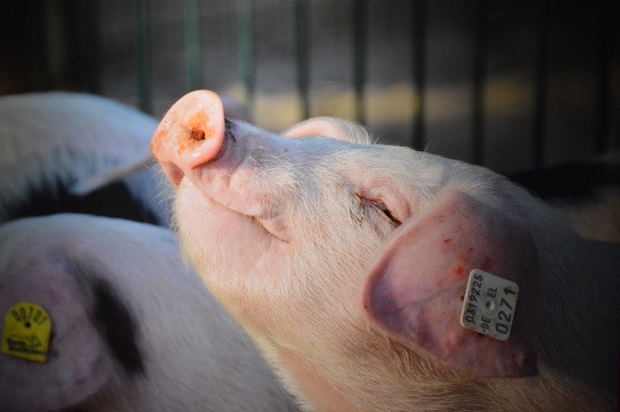







John Wheeler | April 1, 2016
|
I don’t raise pigs, but I have a friend who is looking to start, and he introduced me to the Mangalica/Mangalitsa/Mangalitza, the only existing breed that has long hair. In addition, it is supposed to be superior at putting on fat stores, something eschewed my modern breeders but useful for survival.
And of course there are the Vietnamese pot-bellied pigs, which are not as small as people think, but still much smaller than other breeds. They are a good choice when you don’t have a lot of room for storage after butchering.
Lady Prepper | April 1, 2016
|
I also have friends in Europe raising this type of hogs, and they say the same. They even compare this meat to salmon fish in terms of nutritive substances. I think this breed should be considered for survival.
Rattlerjake | April 2, 2016
|
I presently am raising pot-bellied pigs for my homestead pigs. And am looking at American guinea and New Zealand KuneKune. These pigs are “half” the size of those other ten breeds and suitable for very small subsistence farming.
choppergil | April 3, 2016
|
I raised feeder pigs 30 years ago, here in the south, and sold them at auction, when they weighted about 45 lbs., to farmers who would top them out to a weight of 240 lbs. Pigs eat a lot and you have to see that they get food and grow quickly in order to make a profit. I think growing smaller pigs is a good idea these days because big companies now control almost all the pork industry. Smaller pigs would be easier to handle and would eat less. It’s hard to find pigs to buy pigs now. I live in the country and very seldom see any farms with pigs.
Pingback:10 Breeds Of Hogs To Choose From For Survival | TheSurvivalPlaceBlog | April 4, 2016
|
Paul Schneider | April 5, 2016
|
Interesting article. I’ve been doing survival type ‘adventures’ most of my life. Built a log cabin in upper NW Montana at age 23 with no modern services available, GREAT!! More…
Concerning hogs, what a out the miniatures, like the Pot Bellied Pig, for smaller operations. I don’t need that much meat, pork. I can’t dedicate more than a acre of my land
To a pork operation. Our winters last long and get cold here in central North Dakota, so adequate housing, bedding, cleaning, odor and purchased food supply have stopped me from trying hogs. I have tried Goats and got NAGGED constantly for treats and special food. Presently I have four llamas, the easiest animals I ever Raised, and a huge profit animal awhile back.
Anyway, I’m Impressed with your story and would appreciate your view on the minniature hogs!! Thank you. Paul
Grandpa | April 23, 2016
|
Having experience in raising both Hamps and Yorks I can attest to the taste, quality, and temperament of these hogs. Hamps particularly are like oversized dogs. They like human attention and will follow you around while you mend fence and do other chores. Be careful when bending down to mend a fence, they will rub up against you and their 500# will send you head first down the hill. Haooened more than once to me.
Pingback:Healthy Low Carb Foods To Stockpile For Survival | Prepper's Survival Homestead | June 27, 2016
|
John | May 27, 2017
|
When going Camping
if someone were to Plant
Garden Seeds
nearby,
then you may have
Food growing Wild
next year.